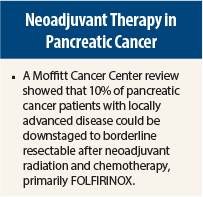Investigators from Moffitt Cancer Center in Tampa, Florida, have reported an approach to pancreatic cancer that downstages some locally advanced patients to borderline resectable status and achieves a negative surgical margin rate exceeding 96%. The study earned a Merit Award at the 2015 Gastrointestinal Cancers Symposium, where Eric A. Mellon, MD, PhD, a radiation oncology resident at Moffitt, presented the findings.1
“Locally advanced pancreatic cancer is considered unresectable; however, we have observed that some of these patients respond sufficiently for resection to be possible,” he told The ASCO Post. “Five of our locally advanced patients were able to have complete resections after neoadjuvant therapy. Out of 49 patients, 5 is not a lot, but normally, this number would be 0, and none of the 5 has recurred.”
The key seemed to be the use of FOLFIRINOX (fluorouracil, leucovorin, irinotecan, oxaliplatin). “I looked for a common thread among these five patients we could take to surgery and saw that they all received FOLFIRINOX,” he said. The other neoadjuvant regimens were gemcitabine-based, including gemcitabine/docetaxel/capecitabine (GTX), gemcitabine/nab-paclitaxel (Abraxane), and gemcitabine alone.
Chemoradiotherapy Strategy
The optimal approach to borderline resectable disease has been controversial, as randomized trial data are lacking. One option, taken at Moffitt, is to give high-dose multiagent chemotherapy, followed by stereotactic body radiation therapy, which can deliver a high radiation dose, shrink gross disease, and enhance the possibility of achieving a margin-negative resection, “the only hope of cure,” he noted. Even if the tumor does not become amenable to resection, “local disease control from radiation therapy may also improve quality of life,” he added.
This neoadjuvant approach resulted in downstaging 10% of patients with locally advanced disease and altogether rendered about 50% of borderline resectable patients amenable to surgery, where surgeons achieved negative margins in 97%. “For borderline resectable disease, this is an extremely high negative margin rate,” Dr. Mellon indicated.
Study Details
The institutional review included all nonmetastatic borderline resectable (n = 110) or locally advanced (n = 49) pancreatic cancer patients treated with stereotactic body radiation therapy between 2009 and 2013 at Moffitt Cancer Center. Borderline resectable patients typically received induction chemotherapy with GTX, while locally advanced patients received FOLFIRINOX or a gemcitabine-based regimen. Definitions for resectability were based on the National Comprehensive Cancer Network guidelines for pancreatic adenocarcinoma.
Patients received stereotactic body radiation therapy in five equal fractions. Dose-painting techniques were used to increase the dose to areas of tumor vessel abutment (30–50 Gy, median 40 Gy). Gross disease received a minimum of 28 Gy.
Fifty-one percent of borderline resectable patients underwent resection, with a 3% positive margin rate. The other 49% did not go to surgery, because they progressed to unresectable or metastatic status on imaging (21%), proved to be unresectable at surgery (7%), demonstrated metastases at surgery (14%), or proved to be medically inoperable due to performance decline during neoadjuvant therapy (7%). Ten percent of locally advanced patients underwent complete resection, and 4% were unresectable at the time of surgery. The other patients (86%) did not have imaging response sufficient for possible resection.
“In our experience, borderline resectable or locally advanced pancreatic cancer status entering the treatment protocol is unimportant, compared with whether patients undergo complete resection,” Dr. Mellon said. In patients who were not surgically resected, the 1-year local tumor control rate was 78%.
Among the locally advanced patients, 21 received FOLFIRINOX and 25 received a gemcitabine-based regimen. Of them, five patients on FOLFIRINOX were downstaged to borderline resectable status, but no patient on a gemcitabine-based regimen was downstaged (P = .015).
“The median follow-up for the five resected locally advanced patients is only 6 months, but none has yet died (P = .09 for survival of resected vs unresected locally advanced patients). We observed that FOLFIRINOX was associated more often with complete resection,” he said.
Mild (grade 1/2) acute radiation-induced toxicities, such as fatigue, pain, nausea, and diarrhea, were common, but chronic radiation-induced toxicities were rare. “No toxicity prevented surgical resection,” Dr. Mellon said.
He noted that FOLFIRINOX is difficult for some patients to tolerate, so patient selection is important. At Moffitt, FOLFIRINOX is reserved for fit, younger patients with locally advanced disease, who require a more aggressive neoadjuvant approach. Borderline resectable patients, he added, are usually well served with a faster, less toxic course of GTX. ■
Disclosure: Dr. Mellon reported no potential conflicts of interest.
Reference
1. Mellon EA, et al: 2015 Gastrointestinal Cancers Symposium. Abstract 360. Presented January 16, 2015.



